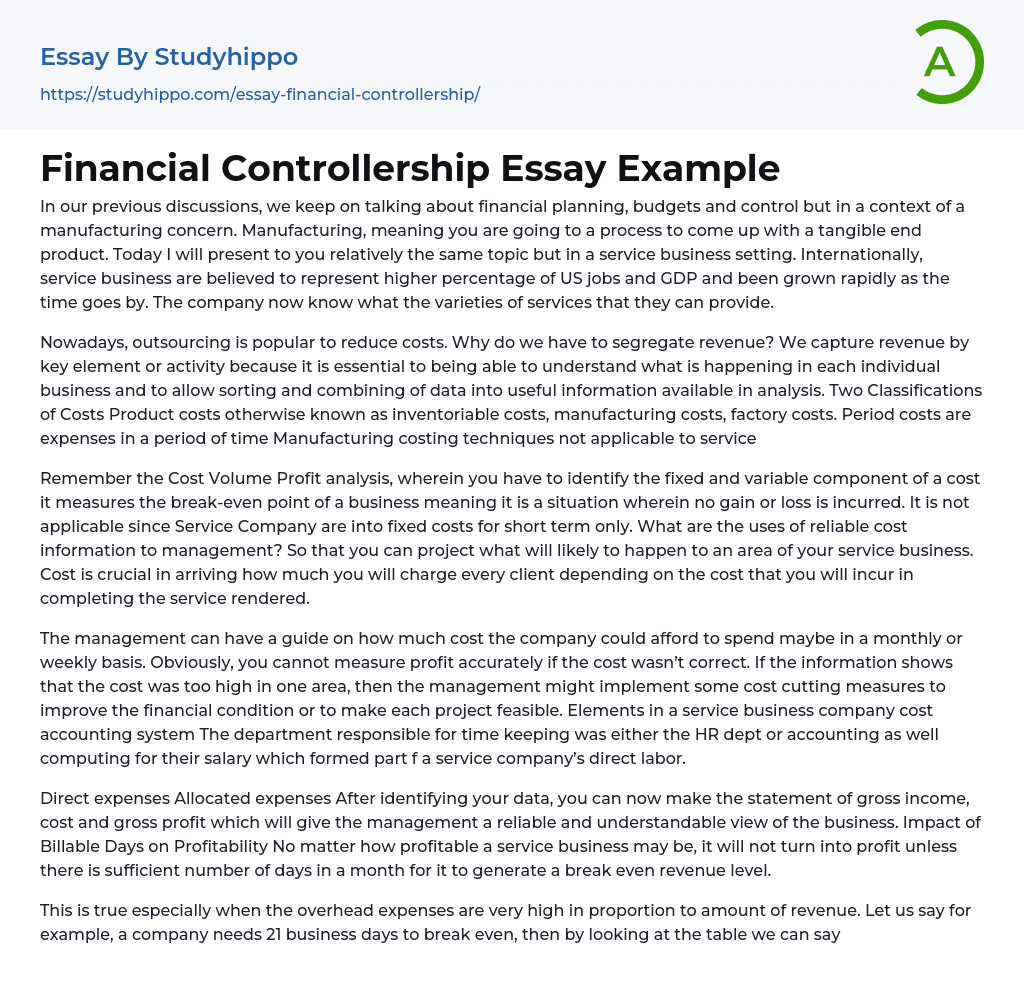In our previous discussions, we keep on talking about financial planning, budgets and control but in a context of a manufacturing concern. Manufacturing, meaning you are going to a process to come up with a tangible end product. Today I will present to you relatively the same topic but in a service business setting. Internationally, service business are believed to represent higher percentage of US jobs and GDP and been grown rapidly as the time goes by. The company now know what the varieties of services that they can provide.
Nowadays, outsourcing is popular to reduce costs. Why do we have to segregate revenue? We capture revenue by key element or activity because it is essential to being able to understand what is happening in each individual business and to allow sorting and combining
...of data into useful information available in analysis. Two Classifications of Costs Product costs otherwise known as inventoriable costs, manufacturing costs, factory costs. Period costs are expenses in a period of time Manufacturing costing techniques not applicable to service
Remember the Cost Volume Profit analysis, wherein you have to identify the fixed and variable component of a cost it measures the break-even point of a business meaning it is a situation wherein no gain or loss is incurred. It is not applicable since Service Company are into fixed costs for short term only. What are the uses of reliable cost information to management? So that you can project what will likely to happen to an area of your service business. Cost is crucial in arriving how much you will charge every client depending on the cost that
you will incur in completing the service rendered.
The management can have a guide on how much cost the company could afford to spend maybe in a monthly or weekly basis. Obviously, you cannot measure profit accurately if the cost wasn’t correct. If the information shows that the cost was too high in one area, then the management might implement some cost cutting measures to improve the financial condition or to make each project feasible. Elements in a service business company cost accounting system The department responsible for time keeping was either the HR dept or accounting as well computing for their salary which formed part f a service company’s direct labor.
Direct expenses Allocated expenses After identifying your data, you can now make the statement of gross income, cost and gross profit which will give the management a reliable and understandable view of the business. Impact of Billable Days on Profitability No matter how profitable a service business may be, it will not turn into profit unless there is sufficient number of days in a month for it to generate a break even revenue level.
This is true especially when the overhead expenses are very high in proportion to amount of revenue. Let us say for example, a company needs 21 business days to break even, then by looking at the table we can say that it’ll lose money in 7 months out of 12. Or if it takes 22 or 23 business days, then there is a serious problem. Otherwise, if the break-even point is 18 business days then the business is assured of generating a profit in every month
in a year. What’s the sense of knowing this break-even level?
I think, so that the company can calculate how much expense reduction is required to reduce the break even point by one incremental day, especially when large number of days is required to break even. This is a good approach in monitoring how well the business is structured to make money through out the year. Planning System Sales budget in a service company just like in manufacturing is said to be the foundation all budgets. In our previous discussion, this budget is most probably come from the top management.
Let us say they want a 500M sales and then the entire operating budget, financial and capital budget or the master budget will dependent on this figure. Before coming up with the figure, these are the possible considerations that the top management consider.
- Company’s growth objectives- You will consider past data on this, add some percentage of growth with the previous reported sale so the management could aim some accomplishments by the end of the year to highlight the success of a business
- Available resources- Will the target revenues achievable with the number of employees the company have? Planned advertising, promotions and PR campaigns- If these expenses are so material in amounts.
- Pricing actions
- Competition-Know your market share thus planning how much would be your revenues
- Growth potential/demographics
- Technological changes- or example online databases
- General economic trends
- Chief Executive Officer essays
- Convenience Store essays
- Firm essays
- Training And Development essays
- Unilever essays
- Variable Cost essays
- Virgin Group essays
- Bargaining essays
- Entity essays
- Pest analysis essays
- Money essays
- Financial Accounting essays
- Market Segmentation essays
- Supply And Demand essays
- Purchasing essays
- Forecasting essays
- Legacy essays
- Bank essays
- Corporate Finance essays
- Financial News essays
- Financial Ratios essays
- Financial Services essays
- Free Market essays
- Shareholder essays
- Personal finance essays
- Equity essays
- Financial Crisis essays
- Banking essays
- Credit Card essays
- Currency essays
- Debt essays
- Gold essays
- Loan essays
- Enron Scandal essays
- Foreign Exchange Market essays
- Investment essays
- Venture Capital essays
- Stock Market essays
- Retirement essays
- Donation essays
- Net Present Value essays
- Income Statement essays
- Commercial Bank essays
- Debit Card essays
- Deposit Account essays
- Subprime Lending essays
- Perfect Competition essays
- Underwriting essays
- Synergy essays
- Valuation essays




